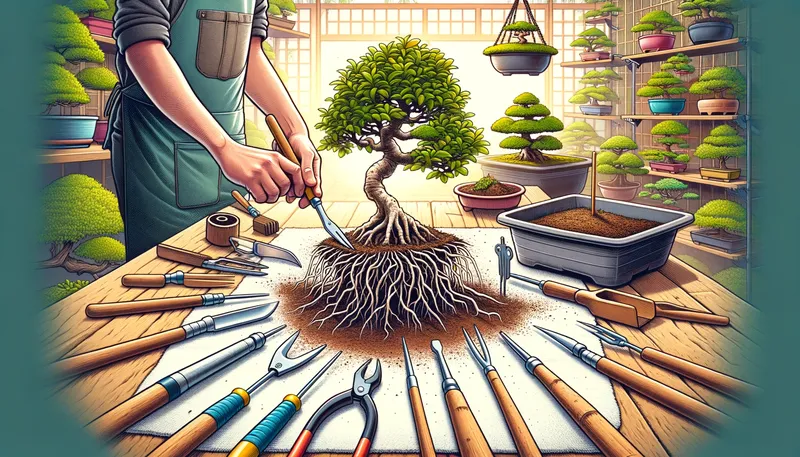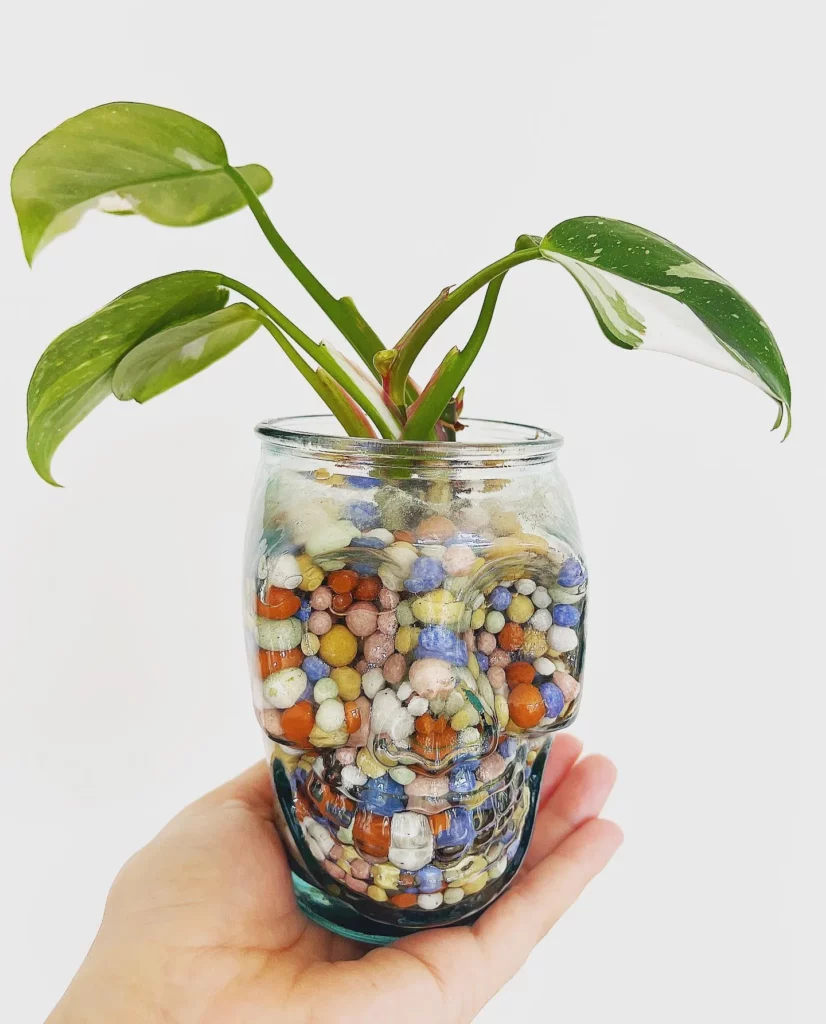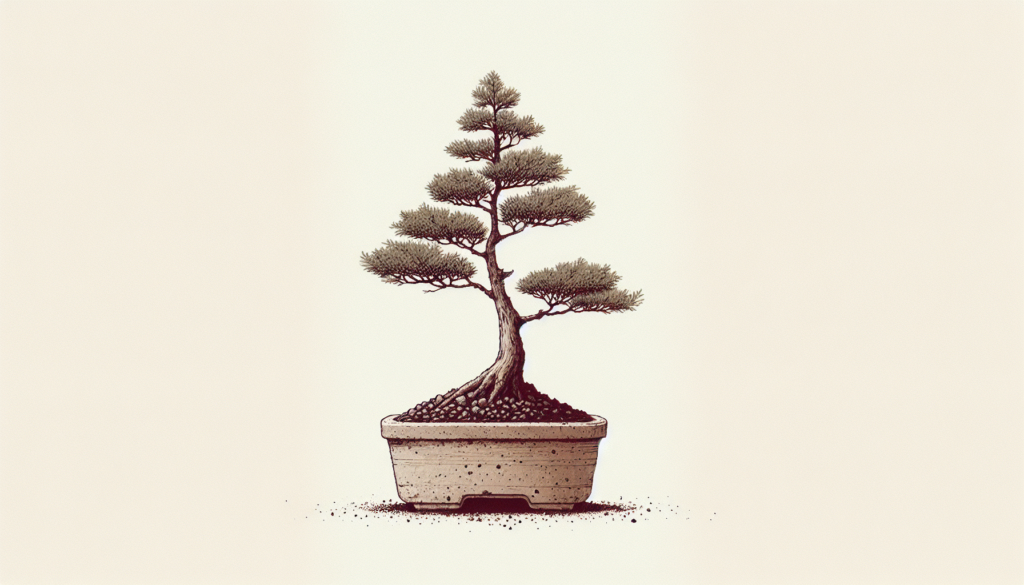Are you a bonsai enthusiast looking to enhance your bonsai cultivation and maintenance? Look no further than the essential bonsai tools that every bonsai enthusiast should have. These tools are must-haves for shaping, pruning, and maintaining your bonsai trees with precision and care.
Bonsai tools come in a variety of shapes, sizes, and designs, each specifically crafted for a unique purpose. Whether you’re a beginner or an experienced bonsai artist, having the right tools is vital for achieving the desired results.
Japanese bonsai tools are renowned for their exceptional quality, but they can be quite expensive. However, Chinese bonsai tools offer excellent quality at more affordable prices, making them a popular choice among enthusiasts.
The most common material used for bonsai tools is black steel, known for its durability and strength. However, stainless steel tools are also available, offering corrosion resistance and a sleek appearance.
It’s crucial to use bonsai tools for their intended purpose and to take proper care of them. By doing so, you can ensure that your tools last for many years, providing you with long-lasting support in your bonsai journey.
Shears and Pliers
Shears and pliers are indispensable tools for any bonsai enthusiast. Shears are designed for cutting twigs, smaller branches, leaves, or roots with precision and ease. Whether you need to trim overgrown branches or shape the foliage, a good pair of shears is essential. When choosing shears, consider the size and shape that will best suit the needs of your bonsai tree.
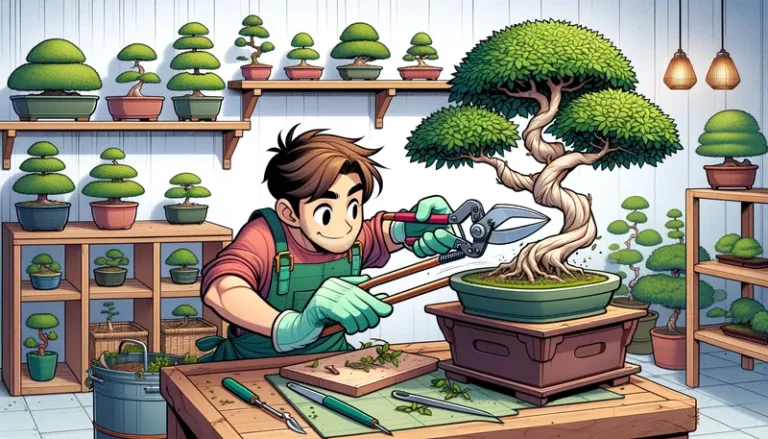
Pliers, on the other hand, are versatile tools that can be used for cutting and working in dense canopies. They provide added control and finesse when you need to make precise cuts or reach tight spaces. With pliers, you can easily tackle intricate tasks and maintain the overall health and appearance of your bonsai.
- Shears are perfect for trimming twigs, branches, leaves, and roots.
- Pliers offer enhanced cutting capabilities and are ideal for working in dense canopies.
Remember to choose the right size shears and pliers for your specific bonsai. Having the proper tools ensures that you can tackle any trimming or shaping task seamlessly and effectively. Invest in high-quality shears and pliers to make your bonsai maintenance a breeze.
Concave Cutters
When it comes to shaping and maintaining your bonsai tree, concave cutters are a must-have tool in your arsenal. These specialized bonsai tools are designed specifically for removing branches from the trunk, allowing for precise and clean cuts.
The unique feature of concave cutters is their ability to create deepened cuts that heal smoothly without leaving behind a swollen scar. This promotes healthier growth and enhances the overall aesthetic appeal of your bonsai tree.
You will find different types of concave cutters available on the market, each suitable for specific purposes:
- Straight Blade Concave Cutters: Ideal for removing branches close to the trunk.
- Semi-Round Blade Concave Cutters: Perfect for removing branches at a slight angle.
- Knob Cutters: Specifically designed for the removal of larger branches and knobs.
It is important to choose the right size of concave cutter based on the thickness of the branches you wish to remove. Using an appropriately sized concave cutter ensures clean cuts and prevents unnecessary damage to the tree.
With concave cutters in your bonsai tool kit, you can confidently shape and refine your bonsai tree, creating a masterpiece that reflects your artistry and skill.
Saws and Knives
When it comes to shaping and maintaining your bonsai trees, there are times when shears and pliers just won’t cut it. That’s where saws and knives come in handy.
Saws:
- Japanese pruning saws are renowned for their quality and efficiency. They are designed to cut when pulled back towards you, ensuring precise and controlled cuts.
- These saws are perfect for tackling branches, trunks, and roots that are too thick or hard for other tools.
Knives:
- Grafting knives play a crucial role in bonsai toolkits. They are used for smoothing cuts and wounds left behind by other tools.
- Professional gardeners often prefer grafting knives due to their precision and versatility.
Whether you need to trim a thick branch or refine a previous cut, saws and knives are essential additions to your bonsai tool collection.
Tools for Working on Roots and Repotting
When it comes to maintaining the health and vigor of your bonsai tree, working on its roots and repotting it periodically is crucial. To make this process easier and more effective, there are specialized tools available designed specifically for these tasks.

Sickle Knives and Saws
Removing the rootball from the pot can be a delicate process. Sickle knives and saws are essential tools for carefully cutting along the inside of the pot and easing the rootball out without causing damage to the tree’s roots.
Root Hooks and Rakes
Opening the rootball and combing the roots is another essential step in repotting a bonsai tree. Root hooks and rakes help in untangling and spreading the roots, ensuring they can grow properly in the new potting medium.
Tools for Sieving Soil Components
Creating the right soil mixture for your bonsai tree is crucial for its overall health and growth. Tools such as sieves allow you to separate different components like akadama, pumice, and lava rock, ensuring you achieve the perfect balance for your tree’s needs.
Scoops for Filling Soil
Once you have prepared the soil mixture, using scoops makes filling the bonsai pot an easier and more efficient process. Scoops allow you to carefully distribute the soil and prevent any damage to the tree’s roots in the process.
Tweezers and Spatulas
When it comes to final touches, tweezers and spatulas are invaluable tools for applying moss to the surface of the soil, giving your bonsai tree that attractive, finished look. Additionally, they can also be used for removing any unwanted weeds or debris that may have found their way into the pot.
Investing in these specialized tools for working on roots and repotting will not only make the process smoother, but it will also help protect the health and longevity of your beloved bonsai tree.
Tools for Wiring and Bonsai Wire
When it comes to shaping and training your bonsai tree, wiring is a crucial technique that requires the right tools. Bonsai wire is used to manipulate branches and guide them into the desired positions. To effectively work with wiring, you’ll need wire cutters to cut and remove the wire when necessary.
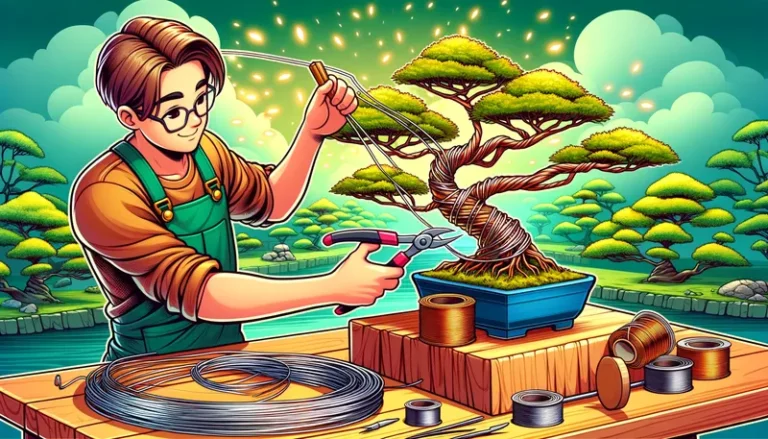
Choosing the correct size wire is essential for successful wiring. The thickness of the wire should correspond to the size and strength of the branches you are working with. Thicker branches require thicker wire for proper support, while thinner branches necessitate lighter wire to avoid damage.
Benefits of Bonsai Wire:
- Allows you to shape and position the branches
- Helps create the desired aesthetic form of the tree
- Aids in the development of bonsai structure
- Enables you to achieve balance and proportion in the design
For beginners, it is recommended to start with aluminum wire. It is easier to apply and manipulate, making it ideal for practicing wiring techniques. As you gain experience and confidence, you can explore other wire materials such as copper or stainless steel for different bonsai trees and specific wiring needs.
Remember, proper technique and care should be exercised when using bonsai wire to avoid causing harm to the branches or trunk. Regularly check and adjust the wire’s tension to ensure it is not cutting into the bark and impeding the tree’s growth. Remove the wire promptly once the branches have set in the desired position to prevent wire scarring.
Investing in quality bonsai wire and wire cutters will enhance your wiring experience and enable you to achieve the desired results. With the right tools in hand, you can confidently shape and train your bonsai tree into a living work of art.
Tools for Bending and Protective Material
When it comes to shaping and bending your bonsai tree, having the right tools is essential. Tools such as ergonomically designed steel levers, clamps, turnbuckles, and rebars can provide the necessary strength and precision for heavy bending. These tools allow you to carefully shape your bonsai according to your desired aesthetic.
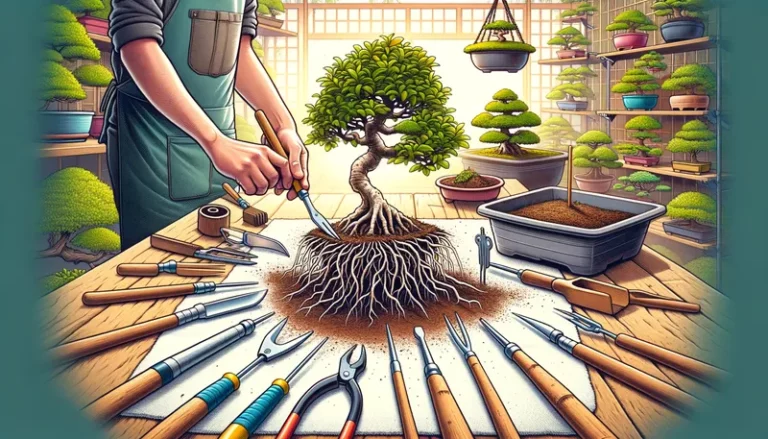
However, it’s important to note that during the bending process, there is always a risk of wood breaking or bark tearing. To minimize this risk and protect your bonsai, it’s crucial to use appropriate protective materials.
Protective Materials
One commonly used protective material is wet raffia. This fibrous material is applied to the trunk or branches before bending to provide cushioning and prevent damage.
Rubber tape is also useful in protecting the bark, providing an extra layer of support and minimizing the risk of tearing. Rubber tubes are another helpful tool for protecting delicate branches during bending, as they provide a barrier between the branch and any bending or shaping tools.
In addition to their protective function, these materials also play a role in the healing process. If minor cracks or fissures occur during bending, the wet raffia, rubber tape, and rubber tubes can aid in the healing process. They create a conducive environment for the bonsai tree to recover, minimizing the risk of infections and promoting healthy growth.
By using the right tools for bending and incorporating protective materials, you can shape your bonsai tree with confidence and minimize the risk of damage. Remember to always handle your tools and protective materials with care to ensure their longevity and effectiveness.
Tools and Carving Knives for Deadwood
Working on deadwood is a crucial aspect of bonsai art. To shape and manipulate deadwood in your bonsai tree, you will need a variety of tools and carving knives specifically designed for this purpose. These tools allow you to lift wood fibers, peel off bark, and shape the deadwood, giving your bonsai tree a unique and dramatic appearance.
Branch Splitters
Branch splitters are used to create clean, straight cuts on larger branches and deadwood. They provide a precise and controlled way to split the wood without causing unnecessary damage. With branch splitters, you can easily remove unwanted branches or shape deadwood with ease.
Jin Pliers
Jin pliers are an essential tool for creating jin, which is the term used to describe deadwood branches in bonsai. These pliers allow you to twist, bend, and shape the deadwood branches, giving them a weathered and aged appearance. Jin pliers are specifically designed to handle delicate deadwood without causing unnecessary stress to the tree.
Chisels
Chisels are versatile tools that can be used for a variety of purposes when working on deadwood. They are perfect for carving intricate details, smoothing rough surfaces, and shaping deadwood. With different chisel sizes and shapes, you can achieve precise and artistic results.
Loop Knives
Loop knives are small, curved knives that are specifically designed for intricate carving. With their sharp and precise blades, they allow you to create fine details and delicate patterns on the deadwood. Loop knives are essential tools for adding texture and character to your bonsai tree.
Carving Hooks
Carving hooks are excellent tools for removing bark and shaping deadwood. These hooks feature a curved blade that can easily lift and peel off the bark, giving the deadwood a more natural and weathered appearance. With carving hooks, you can add depth and dimension to your bonsai tree’s deadwood.
Gas Torches
Gas torches are used to burn off wood fibers from deadwood. By carefully applying heat, you can create beautiful patterns and textures on the surface of the wood. Gas torches are an essential tool for adding depth and character to your bonsai tree’s deadwood.
Brushes
Brushes are used to remove charred wood and residue left from burning deadwood. They help you clean and refine the surface, revealing the natural beauty of the wood. Brushes are crucial for achieving a polished and well-maintained appearance for your bonsai tree’s deadwood.
Wood Hardeners and Jin Liquid
Wood hardeners and jin liquid are used to preserve decayed deadwood in your bonsai tree. These products strengthen the wood and prevent further decay, ensuring that your deadwood remains intact and stable for years to come. Applying wood hardeners and jin liquid is essential for maintaining the longevity and aesthetics of your bonsai tree’s deadwood.
Miscellaneous Bonsai Tools
Aside from the essential tools for repotting, wiring, bending, and carving, there are various miscellaneous bonsai tools that can assist you in your bonsai cultivation and maintenance journey. These tools serve specific purposes, helping you achieve optimal results and care for your bonsai trees effectively.
Raffia
Raffia is a natural fiber that is used in bonsai for multiple purposes. It provides protection to branches during wiring, preventing the wire from cutting into the bark. Raffia also helps in securing wounds and promoting healing by maintaining moisture levels.
Disinfectants
Disinfectants play a crucial role in preventing the spread of diseases and pests in bonsai trees. They can be used to sterilize tools, pots, and work surfaces, reducing the risk of contamination and promoting overall tree health.
Oils
Bonsai oils are specially formulated to moisturize, condition, and protect the trunk, branches, and leaves of your bonsai trees. These oils nourish the tree, prevent moisture loss, and enhance the natural beauty of the wood.
Brushes
Bonsai brushes are essential for maintaining the cleanliness and overall appearance of your bonsai trees. They are used to remove dust, debris, and deadwood from the foliage and branches, ensuring a pristine and healthy environment for the tree.
Other Miscellaneous Tools
Other miscellaneous bonsai tools include root cutters for precise root pruning, humidity trays for maintaining proper moisture levels, moisture meters for monitoring soil moisture, and grafting tools for advanced bonsai techniques.
By having these miscellaneous bonsai tools at your disposal, you can address specific needs and challenges that may arise during the care and maintenance of your bonsai trees. Each tool serves a unique purpose, contributing to the overall health, aesthetics, and longevity of your bonsai collection.
Electric Bonsai Tools
When it comes to more complex and advanced tasks in bonsai cultivation, electric bonsai tools are a game-changer. These tools, such as Dremel and Makita machines, provide the precision and power needed for tasks like carving, sanding, and shaping deadwood.
To achieve the intricate details and smooth finishes required for these tasks, electric bonsai tools offer convenience and efficiency. With their adjustable speed settings and various attachments, you can tailor their usage to specific requirements.
However, it is crucial to exercise caution when using electric bonsai tools, especially due to their powerful nature. Protective gear, such as goggles, gloves, and dust masks, should always be worn for personal safety and respiratory protection.
Overview of the Top 10 Bonsai Tools
When it comes to bonsai cultivation and maintenance, having the right tools is essential. Whether you’re a beginner or an experienced bonsai enthusiast, these top 10 bonsai tools will help you achieve stunning results. From pruning and styling to repotting and carving, these tools are must-haves for any bonsai gardener.
Bonsai Scissors
- Used for precise trimming of leaves, branches, and roots
- Available in various sizes for different bonsai tree types
Branch Cutters
- Designed for cutting branches cleanly and smoothly
- Available in different sizes and shapes to suit your bonsai needs
Knob Cutters
- Specifically used for cutting away knobs or unwanted branch stubs
- Creates a concave cut that promotes healing and prevents scars
Wire Cutters
- Essential for cutting and removing bonsai wire
- Choose a size that matches the thickness of the wire you’re working with
Root Cutters
- Used for pruning and trimming bonsai tree roots
- Creates clean cuts without damaging the tree
Rakes
- Helps in combing and untangling bonsai roots
- Available in different styles, such as bamboo and metal
Bonsai Tweezers
- Perfect for delicate tasks like removing weeds and applying moss
- Provides precision and control for detailed work
Jin Pliers
- Used for creating and shaping deadwood features
- Allows you to bend and lift wood fibers with ease
Bonsai Carving Tools
- Specifically designed for carving intricate details into deadwood
- Offers different tools for different carving techniques
Sickles
- Used for removing the rootball from the pot and cutting along the inside of the pot
- Helps in repotting and rootwork
Shaping and Training with Wire
Bonsai wire is an essential tool for shaping and training bonsai trees. It allows you to bend branches and trunks into desired positions, creating the beautiful and intricate designs that are the hallmark of bonsai artistry. By carefully wrapping the wire around the branches and trunk, you can guide their growth and achieve the desired aesthetic.
Bonsai wire comes in different thicknesses and materials to suit various needs. Anodized aluminum wire is commonly used for its flexibility, ease of use, and affordability. Copper wire is another popular option, known for its strength and durability. Stainless steel wire is the strongest and is often preferred for larger and older bonsai trees.
When using bonsai wire, it’s important to check the tree regularly and adjust or remove the wire as needed. Leaving the wire on for too long can cause it to cut into the bark, resulting in damage to the tree. By monitoring the growth and development of your bonsai, you can ensure that the wire does not impede its health and vitality.
FAQ
Q: What are bonsai tools?
A: Bonsai tools are essential equipment for cultivating, shaping, and maintaining bonsai trees. They come in various shapes, sizes, and designs, each serving a unique purpose. These tools are specifically designed for bonsai tasks to ensure proper care and maintenance of bonsai trees.
Q: What are shears and pliers used for in bonsai?
A: Shears are used for cutting twigs, smaller branches, leaves, or roots, while pliers are also used for cutting and can be helpful for working in dense canopies. Choosing the right size shears and pliers is important, depending on the size of your bonsai.
Q: What are concave cutters and their purpose in bonsai?
A: Concave cutters are specialized bonsai tools used for removing branches from the trunk. They create deepened cuts that heal without leaving a swollen scar. There are different types of concave cutters available, including those with straight blades, semi-round blades, and knob cutters, each matching the thickness of the branches being removed.
Q: What are the uses of saws and knives in bonsai?
A: Saws are used for cutting branches, trunks, and roots that are too thick or hard for shears or pliers. Japanese pruning saws cut when pulled back towards the user. Grafting knives, on the other hand, are used for smoothing cuts and wounds left by other tools, making them most suitable for professional gardeners.
Q: What tools are needed for working on roots and repotting bonsai trees?
A: For working on roots and repotting bonsai trees, tools such as sickle knives and saws are used to remove the rootball from the pot and cut along the inside of the pot. Root hooks and rakes are used to open the rootball and comb the roots. There are also tools for sieving soil components and scoops for filling soil into bonsai pots. Tweezers spatulas are useful for applying moss or removing weeds.
Q: What are the tools used for wiring in bonsai?
A: Wiring is an important technique in bonsai, and specialized tools are available for this purpose. Bonsai wire is used to shape and train branches. Wire cutters are necessary for cutting and removing wire. It is important to choose the right size wire and wire cutters for the branches you are working with. Beginners should start with aluminum wire, as it is easier to apply.
Q: What tools are used for bending and what protective materials are necessary?
A: For heavy bending, tools like ergonomically designed steel levers, clamps, turnbuckles, and rebars can be helpful. Protective materials such as wet raffia, rubber tape, and rubber tubes can prevent wood from breaking or bark from tearing during bending. These materials also aid in the healing process of minor cracks and fissures.
Q: What tools and knives are used for working on deadwood in bonsai?
A: Working on deadwood is a crucial aspect of bonsai art. Tools such as branch splitters, jin pliers, chisels, loop knives, and carving hooks are used for lifting wood fibers, peeling off bark, and shaping deadwood. Gas torches are used to burn off fibers, and brushes are used to remove charred wood. Wood hardeners and jin liquid are used for preserving decayed deadwood.
Q: What are some miscellaneous bonsai tools available?
A: Various miscellaneous bonsai tools are available for tasks such as repotting, wiring, bending, and carving. These tools include raffia, disinfectants, oils, brushes, and more. Each tool serves a specific purpose in bonsai cultivation and maintenance.
Q: What are electric bonsai tools used for?
A: Electric bonsai tools, such as Dremel and Makita machines, are used for more complex and advanced tasks such as carving, sanding, and shaping deadwood. These tools require caution and protective gear when in use.
Q: What are the top 10 essential bonsai tools?
A: The top 10 essential bonsai tools include bonsai scissors, branch cutters, knob cutters, wire cutters, root cutters, rakes, bonsai tweezers, jin pliers, bonsai carving tools, and sickles. These tools are necessary for various bonsai tasks, from pruning and styling to repotting and carving.
Q: What is bonsai wire used for?
A: Bonsai wire is an important tool in shaping and training bonsai trees. It is used to bend branches and trunks into desired positions. Bonsai wire comes in different thicknesses and materials, such as anodized aluminum, copper, and stainless steel. The wire should be checked regularly and adjusted or removed as needed to prevent damage to the tree.

